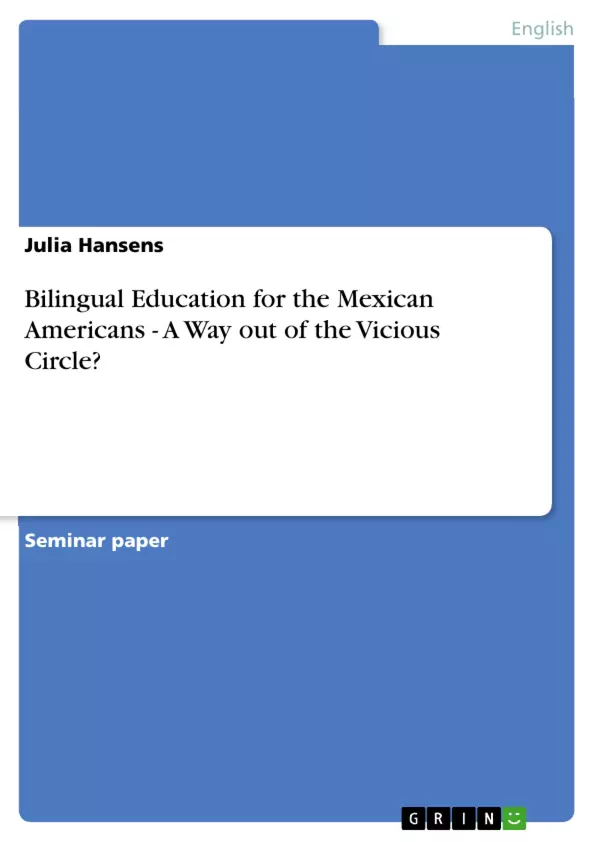This paper on the Mexican Americans in the south-western states in the United States aims at examining whether bilingual education of this ethnic group could be a means to help the Mexican Americans escape the vicious circle they live in.
The introduction will give a short historical overview over the Mexican Americans′ schooling.
In the main part, the description of what is referred to as vicious circle will be followed by the depiction of the Mexican Americans′ situation in school in the south-western states of the United States. As this situation cannot be considered as good, the Bilingual Education Act of 1968 which marked a first step towards an improvement will be introduced. Apart from that, two models of bilingual education will mainly find reconsideration and will be compared with each other regarding their usefulness to give the Mexican Americans an equal educational opportunity as the Anglo Americans have. Towards the end of the main part, the attempt will be made to answer the topic question of this paper. Several obstacles on the way to ′good′ bilingual schooling and possible alternatives will be mentioned then.
The concluding remarks will sum up the result of this paper and will shortly focus on the contemporary situation of the Mexican Americans in the American school system.
[...]
Inhaltsverzeichnis (Table of Contents)
- Introductory Remarks
- Introduction
- Bilingual Education for the Mexican Americans - A Way out of the Vicious Circle?
Zielsetzung und Themenschwerpunkte (Objectives and Key Themes)
This paper aims to examine whether bilingual education could help Mexican Americans escape the vicious circle they experience in the United States, specifically in the south-western states. The paper explores the historical context of their schooling, their educational situation in the region, and the potential of bilingual education as a solution.
- The historical development of Mexican American schooling and the challenges they face
- The vicious circle of poverty, discrimination, and educational disadvantages experienced by Mexican Americans
- The potential of bilingual education to provide equal educational opportunities
- The impact of language barriers on Mexican American students' academic success
- The importance of addressing social and economic factors that contribute to the Mexican American's educational disadvantage
Zusammenfassung der Kapitel (Chapter Summaries)
- Introductory Remarks: This section provides an overview of the paper's focus and aims. It highlights the historical context of Mexican American schooling and the vicious circle they face, setting the stage for the analysis that follows.
- Introduction: This chapter delves into the history of Mexican American schooling, highlighting their cultural exclusion and the persistent segregation they experienced, particularly during the 1930s. The section sheds light on the justifications for segregation, which included the belief that Mexican Americans were inherently inferior and needed to be "Americanized" through English-only education.
- Bilingual Education for the Mexican Americans – A Way out of the Vicious Circle?: This chapter focuses on the educational challenges facing Mexican American students, specifically their lower academic attainment compared to Anglo Americans. It explores the social, economic, and educational factors that contribute to their retardation, including poverty, linguistic barriers, and the mismatch between their cultural backgrounds and the dominant school system. The section also discusses the potential of bilingual education as a tool to overcome these challenges and provide equal educational opportunities.
Schlüsselwörter (Keywords)
Bilingual education, Mexican Americans, educational disadvantage, vicious circle, language barriers, cultural exclusion, socio-economic factors, equal educational opportunities, Anglo Americans, discrimination.
- Quote paper
- Julia Hansens (Author), 2002, Bilingual Education for the Mexican Americans - A Way out of the Vicious Circle?, Munich, GRIN Verlag, https://www.hausarbeiten.de/document/8041


